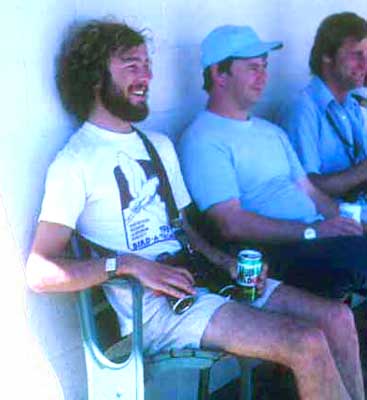 John
Sterling is an active California birder who grew up in Napa County and
then attended Humboldt State University. He is of a slightly younger generation
than most of those listed among out 'top 40' birders from the 1965-1989
era. He began birding in 1971 and met Mike & John Parmeter in 1973.
He was in his teens during much of the '70s, and often birded with the
Parmeters, Gordon Bolander, and L.C. Binford. He first appears in American
Birds with a Scissor-tailed Flycatcher at Oasis in 1977. He was active,
especially in the northwest, during the 1980s and became more prominent
in the Statewide birding world after the close of our period of review
in 1989. John
Sterling is an active California birder who grew up in Napa County and
then attended Humboldt State University. He is of a slightly younger generation
than most of those listed among out 'top 40' birders from the 1965-1989
era. He began birding in 1971 and met Mike & John Parmeter in 1973.
He was in his teens during much of the '70s, and often birded with the
Parmeters, Gordon Bolander, and L.C. Binford. He first appears in American
Birds with a Scissor-tailed Flycatcher at Oasis in 1977. He was active,
especially in the northwest, during the 1980s and became more prominent
in the Statewide birding world after the close of our period of review
in 1989.
John's influence on the California birding scene would begin with his college days at HSU, beginning in 1979 and into the mid-1980s. Not only was he an active Humboldt County birder, but he was a leader and mentor for a wide group of other birders at that time. John encouraged and challenged a generation of new birders. Together, they called themselves "the vagrants." Among the challenges to remain in this elite set was the requirement to bird in every county in California, and preferably to search out at least 100 species in each of the 58 counties. This was essentially a new approach to State birding. Those who heavily birded the State in the 1970s thought of it as a whole, and searched primarily for new State birds and vagrants of Statewide interest. Only a very few (including Rich Stallcup, John Luther, and Dick Erickson) paid attention to county lines or compiled their own county lists for every county. Now, John Sterling would challenge all birders to do just that. In time — and well after the close of our period of review — this concept would catch fire and a host of new birders would take up this goal. Today, over 50 birders belong to John's 'county listing' web group, and regularly report their 58 county lists to him in exchange for multicolored personalized maps of how they are doing. It takes 100 species to fill in a county in purple, 125 species to reach a blue color, 150 species for green, and so on. This spawned a whole new lingo as well — to "go green in Sierra," for example, would come to mean reaching the 150 species mark on your Sierra County list. While these county listing goals may serve mostly as a game to the participants, the inevitable byproduct has been a huge increase in awareness of the details of status and distribution of even the most common birds in California. In addition, numerous 'first county records' are directly attributable to John's influence and his 'vagrants' that began in the '80s. John himself has contributed at least 66 first county records in his own efforts to bird every county (through 2005). He and Peter Metropulos were the first to "discover" that the Big Sur River mouth in Monterey County was a prime vagrant spot. Indeed, to date John has reached the astonishing 200 species level in 55 of California's 58 counties. John has also been an advocate of "no introduced birds" [=NIB] in all listing endeavors. John did not start this movement (indeed, he says it was Dick Erickson who convinced him to go this direction), but all those "vagrants" and "county listers" who report via John's web pages do so NIB. Statewide, this excludes ten species that are on the official CBRC state list (now that Eurasian Collared-Dove has become the 10th non-native to be accepted as "established" under CBRC guidelines). It also avoids the many disputes that come with determining what non-native species are or are not "established" on a county to county basis. John now resides in Yolo County and is an environmental consultant for H.T. Harvey & Associates. He is currently (2005) active as the President of the Central Valley Bird Club (and writes a quarterly column for their newsletter), a member of the CBRC, a board member for Sacramento River Watershed Program, and is the N. CA editor for EBird. Photo 30 May 1982 at Dyer, Nevada; John sips a Mountain Dew next to Phil Swan & Paul Lehman; © D. Roberson Official Bird Name: Lesser Roadrunner *
|
|
|
|
Selected publications since 1989:
|